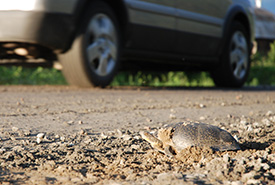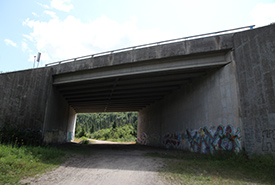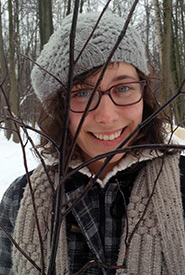Stop Carcasses! Safer roads for animals and people

A turtle on the roadside with a car speeding by it. (Photo by NCC)
Working in conservation sometimes means bringing harsh realities to light. As a communications assistant with the Nature Conservancy of Canada’s (NCC’s) Quebec Region, I promote projects aimed at preventing road kill.
Up until recently, whenever I saw a dead animal on the road, I let awkwardness and discomfort eat away at me, pretending I hadn’t seen it. But something occurred recently that made me realize that something had shifted in me.
Related content
For years, I’d been having a recurring dream where I hang out, carefree, by a stretch of crystalline water. A couple of weeks ago, I had that dream, but with a strange twist: as I was getting ready for a swim, I was struck by the sight of a dead doe lying on the bank.
I had been promoting the Stop Carcasses! project, a not-for-profit initiative that aims to reduce animal-vehicle collisions. I guess I had reached the point where it had become impossible for me not to see the consequences of traditional road design.
Run-ins with animals on the road is a great safety hazard for both animals and drivers, yet they remain mostly undetected. The Quebec Ministère des transports keeps records of reported collisions with large animals, such as bear, deer and moose. In the Laurentians, 5,150 collisions with large animals were reported between 2010 and 2017. However, as collisions with small mammals, reptiles and birds are not accounted for, it is difficult to estimate the total number of animals hit by vehicles in the region.
More than 100 turtles are crushed by cars every year in Quebec. They are among the most affected species. While this might seem like a low number, scientists have found that an annual mortality rate of more than five per cent in a population of wood turtles and Blanding’s turtles could lead to their decline. The turtle situation in Quebec is already a precarious one; all eight species found in the province are at risk, either provincially or federally. Factoring in turtles' very low reproduction rate, collisions with cars are a great threat to them.

A future wildlife underpass in the Laurentians. (Photo by NCC)
This is why we, as citizens, need to contribute to initiatives like Stop Carcasses! This iNaturalist app, developed by The Ruiter Valley Land Trust, allows you to upload pictures of animals you see on the road, whether dead or alive, along with the details of the observation. The iNaturalist community then helps identify the species in the photos, allowing conservation groups, scientists and authorities to get a clearer picture of the situation.
Stopping the car to take a picture of a dead animal might seem inconvenient. But this data helps scientists map animals’ movements, identify hot spots for animal-vehicle collisions and propose solutions, such as wildlife crossings, to help animals cross roads safely.
Please help us keep animals and drivers safe by participating in projects like Stop Carcasses! The program is currently active in six regions in Quebec: Eastern-Townships, Outaouais, Gaspésie, Centre-du-Québec, Bas-Saint-Laurent and Laurentides.
For more information about the project and how you can help, click here.
WildPaths
If you live in the Maritimes or the northeastern United States, you can participate in WildPaths, an app similar to Stop Carcasses!
For WildPath Maritimes, click here.
For WildPath United States, click here.


